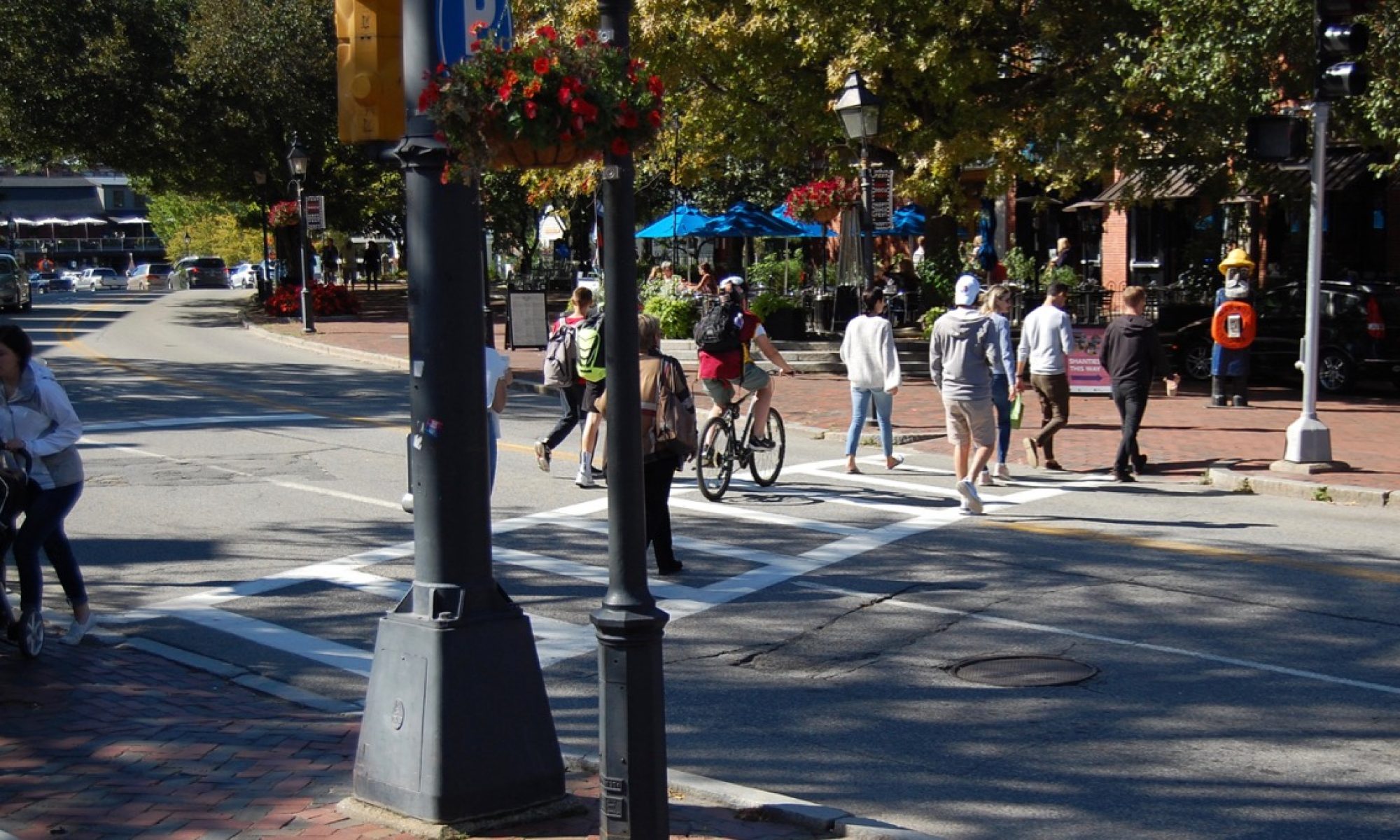Our last post discussed how speeds on wide neighborhood streets can be tamed through the addition of traffic calming devices such as curb extensions and chicanes. These measures take advantage of the extra space available between the curbs to create horizontal deflections in the path of vehicle travel, which helps to reduce speed and make drivers pay more attention to their surroundings.
Even where traffic calming isn’t an issue, excess pavement can be reclaimed for stormwater management using measures that mimic natural systems. The Newburyport Climate Resiliency Plan (October 2020) recognizes the environmental impact of the combination of wide streets and older stormwater collection systems:
Given today’s requirements, … certain side streets such as Oakland and Tyng seem to be unnecessarily wide; 45-50 feet in width …. Aside from providing on street parking (that already duplicates existing paved off-street parking), the added pavement only increases impermeable surface stormwater runoff, drives heat island effects that increase summer temperatures, increases road paving costs, and adds to the city’s snow removal load. As precipitation volumes increase and aging underground drainage pipes can’t handle the runoff …, residents and businesses located downstream will suffer the consequences of these wide streets. (p. 104)

To address these issues, the Resiliency Plan recommends that the City consider converting excess pavement to green space on some of the streets between High and Merrimac Streets:
As part of a citywide stormwater management program, inventory impervious surfaces uphill of Merrimac St. towards High St. Reductions in impervious surfaces would reduce heat island effects, storm water runoff, road maintenance and snow plowing costs. Consider methods to increase rainfall infiltration. (p. 121)
Consider narrowing all unnecessarily wide streets.
Work with a neighborhood to develop a demonstration project to narrow a wide street. Run utilities under the sidewalks, expand green areas to where pavement once was, plant trees to the side of sidewalks, and install a municipal rainwater collection system as well rainwater catch basins. The design with some integrated along street parking would also serve to naturally slow vehicular traffic. (pp. 125-126)
The Resiliency Plan presents these recommendations as short-term strategies, to be completed between now and 2030. A neighborhood demonstration project would demonstrate both the challenges and the environmental benefits of this retrofit strategy, which could be replicated on other wide streets where appropriate.
Much of Newburyport’s stormwater is simply collected in catch basins and carried by a system of underground pipes to outfalls along the Merrimack River. The map below, from Newburyport’s MIMAP GIS viewer, shows the portion of this system along Oakland, Tyng and Broad Streets between High Street and Merrimac Street.

With the increased intensity of rainfall that is happening as a result of climate change, these stormwater systems will reach their capacity more often, resulting in the flooding of streets and private properties. In addition, the existing system provides little to no removal of roadway pollutants (like oil and salt) before the water reaches the river, and the aging facilities may need to be repaired, replaced or upgraded over time. Rather than continue to pipe untreated water below the street, we have the opportunity to consider converting some of the excess pavement into above-ground facilities that mimic natural systems, allowing vegetation to slow and filter the runoff from heavy rainfall, as well as permitting some of the runoff to infiltrate into the ground rather then flow to the Merrimack.
The sketches below were prepared in October 2010 as part of a “what-if” exploration of ways to incorporate low-impact development strategies into Newburyport’s wide streets. They illustrate one way in which excess pavement on a low-volume street might be reclaimed to provide stormwater management that mimics natural systems. Move the slider to compare the existing cross-section on the left with an alternative layout on the right that provides the same traffic-carrying capacity but is better for the environment.


Source: October 2010 presentation by Ellie Baker (Horsley Witten) & Bob Uhlig (Halvorson | Tighe & Bond Studio)
Communities across the country have been implementing green infrastructure strategies like this for more than two decades, so there is a good deal of knowledge to build on. The photos below provide just a few examples of how introducing stormwater management measures along a street can enhance the neighborhood environment while treating stormwater before it reaches wetlands and rivers.




The design of these types of measures would need to be considered in context of each neighborhood and street, but there are many examples that we can draw from to make our streets better for the environment, healthier, and safer for all of us.
•••••
To see more examples of the ways that space can be reclaimed from pavement to manage stormwater and enhance the character of a residential neighborhood, you can look for the Twitter account of Dongho Chang, Seattle’s Traffic Engineer. (In fact, Chang’s Twitter feed is a wonderful exploration of the many ways that streets can be retrofitted to be more livable.)
Another resource is the National Association of City Transportation Officials (NACTO) Urban Street Stormwater Guide, including this page on Residential Streets.

